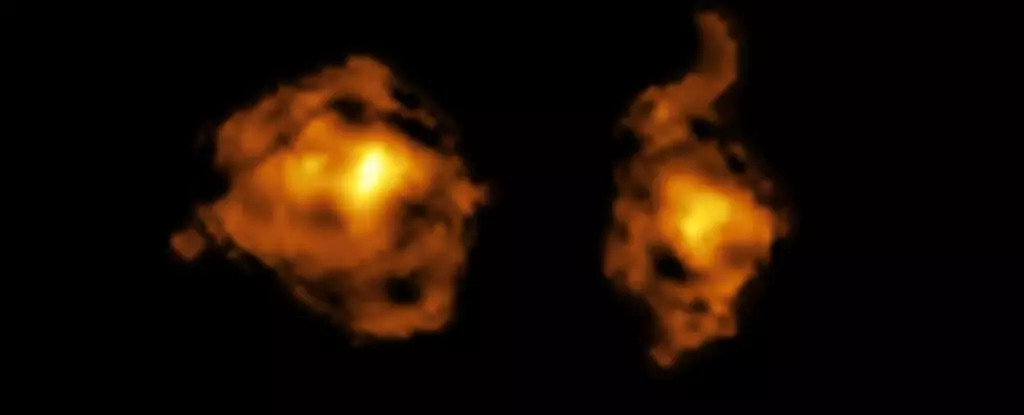In an extraordinary revelation, astronomers have recently captured the breathtaking moment when one galaxy collides with another, propelled by an intense beam of radiation emanating from its central black hole. This stunning event, dubbed the “cosmic joust,” represents a landmark in our understanding of galactic interactions. The massive energy at play is altering the fabric of the ‘wounded’ galaxy, inciting a powerful suppression of star formation. This encounter offers a visual and scientific spectacle that raises profound questions about the evolutionary pathways of galaxies and their central black holes.
The Mechanics of a Galactic Encounter
Galactic mergers are not just random occurrences but are central to the cosmic drama that unfolds in our universe. As galaxies traverse through the vast expanse, they are interconnected through an intangible web of dark matter. This gravitational force orchestrates a grand ballet, drawing galaxies into clusters where collisions can occur, ultimately leading to the formation of larger galactic entities. While these cosmic dances play out over millions of years, the implications for star formation and the growth of supermassive black holes at their centers are immense.
The cosmic joust currently unfolding sees one of the colliding galaxies exhibiting the characteristics of a quasar—a highly active and luminous phase in which a supermassive black hole devours material at a staggering rate. This phase elevates the local environment’s energy and luminosity, creating conditions ripe for one of the most impressive sight lines in the universe. As the quasar galaxy races past its counterpart at around 500 kilometers per second, its high-energy jets penetrate the gas and dust of the other galaxy, significantly disrupting its star-forming clouds.
A Devastating Impact on Star Formation
The aftermath of this cosmic joust reveals the detrimental effects of such high-speed encounters on galactic evolution. The beams of radiation from the quasar effectively obliterate the material necessary for star formation, stripping away the very clouds that nurture infant stars. This circumstances leads to a stark decline in star formation activity within the impacted galaxy, illustrating a cosmic irony: as one galaxy thrives in its quasar phase, another suffers under the energetic onslaught.
However, the devastation does not stop at mere suppression. As the quasar siphons gas from the wounded galaxy, this material becomes fuel for the insatiable black hole, exacerbating its active state. This long-term feeding frenzy not only diminishes the galaxy’s potential to form new stars but also contributes to a relentless cycle where quasar activity quenches star formation across the cosmic landscape.
Yet Hope Shines Amidst the Chaos
Despite the apparent devastation, the cosmic joust holds a silver lining. Galaxies are renowned for their resilience; they often find ways to adapt and regenerate. The violent encounters between colliding galaxies can initiate the conditions for new stellar births. The shocks generated from these high-energy encounters can lead to regions of higher density within the gas. Such conditions can spur gravitational collapses that potentially seed new stars and structures, reminding us that disruption can lead to rejuvenation on a cosmic scale.
Even in the infancy of our vast universe, these collisions represent both an end and a beginning. They are emblematic of the complex interplay between destruction and creation—a stellar rejuvenation driven by the formidable forces of gravity, radiation, and turbulence. In this context, the cosmic joust is not merely a testament to destruction but an ongoing narrative of resurgence, acting as a catalyst for a renewed era of star formation and structural evolution.
Rethinking Galactic Evolution
This breathtaking study fundamentally shifts our perspective on galactic evolution. It suggests that the interactions between galaxies and their supermassive black holes are far more intricate than previously imagined. The insight into how quasar jets can directly affect the internal dynamics of neighboring galaxies opens new avenues for research. We are invited to rethink our understanding of how galaxies evolve, interact, and contribute to the rich tapestry of the cosmos. In contemplating these expansive interactions, it becomes clear that the universe is a stage for cosmic clashes that foster both chaos and beauty—reminding us of the perpetual cycle of birth and rebirth that defines the cosmos as we know it.


Leave a Reply